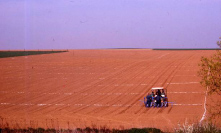Context
Insecticide treatment using seed as a vehicle has been widely used practice since the advent of neonicotinoïds-based compounds. This method is not only able to protect seed or young plant against armful organisms in the beginning of the plant development, but also to protect crop during several weeks or months.However, except pelleted beet seeds, which are generally well treated, application quality is often bad, especially homogeneity of individual dose on each seed, particularly in cereals.
Neither the guidelines of EPPO nor CEB themselves, which are written for well-conducting efficacy trials for registration and for giving bases for doses choice, do not explicitly prescribe any chemical analysis of seeds before their use in trials.
In the field of seed by seed doses homogeneity, some states are tempted to impose specifications on pure theoretical bases. Seed treatment quality level needed for obtaining a good agronomic efficacy is unknown.
Objectives
To determine the needed quality level to insure a good protection of crops against pests in different situations (kind of sowing, of pest, of compound), in order to build specifications for seed treatment quality on agronomic bases.Results obtained
1.Seed by seed analysesIn this project, frequency distribution of doses receipt by single seeds is obtained by chemical HPLC / GC or near infrared spectroscopy analyses (NIRS).
2.Variable dispersion of individual doses
From several parent-batches of seeds treated at different dose levels of the same product, a large range of son-batches can be composed, with a common average dose between son-batches, and different dispersions of individual doses around the mean dose.
For instance, son-batches of average dose of “50g/U” can be made with 100% seeds of the “50g/U parent-batch”, as well as with 50% of the “50g/U parent-batch” + 25% of “25g/U parent-batch” + 25% of the “75g/U parent-batch”.
According to proportions of parent-batches composing a son-batch, dispersion of the individual doses can be less or more wide.
These son-batches can be tested in field trials for measuring impact of seed by seed doses distribution on agronomic efficacy.
Parent-batches need to be treated with an excellent seed by seed distribution, to obtain son-batches with an identical average dose and contrasted seed by seed distribution.
3.Field trials
Homogeneity level needed to able a seed treatment to give a good protection of the crop is not the same for all kind of pests, all sowing density nor all product mobility.
Trials have to be conducted distinguishing these different parameters.
Until now, trials have been conducted on different pests in sugar beet and in corn. In these both crops, the first results showned a tolerance for seed treatment heterogeneity more important than supposed, with neonicotinoïd insecticides like imidacloprid or thiamethoxam, in spite of the very low sowing density. It suggests that studied pests where rather mobile.
Experimentation will go on with other pests of these crops. Results obtained with different pests will be able to be compared.
Contribution
...Partners
...Funding
- CRA-W - Walloon Agricultural Research Centre

